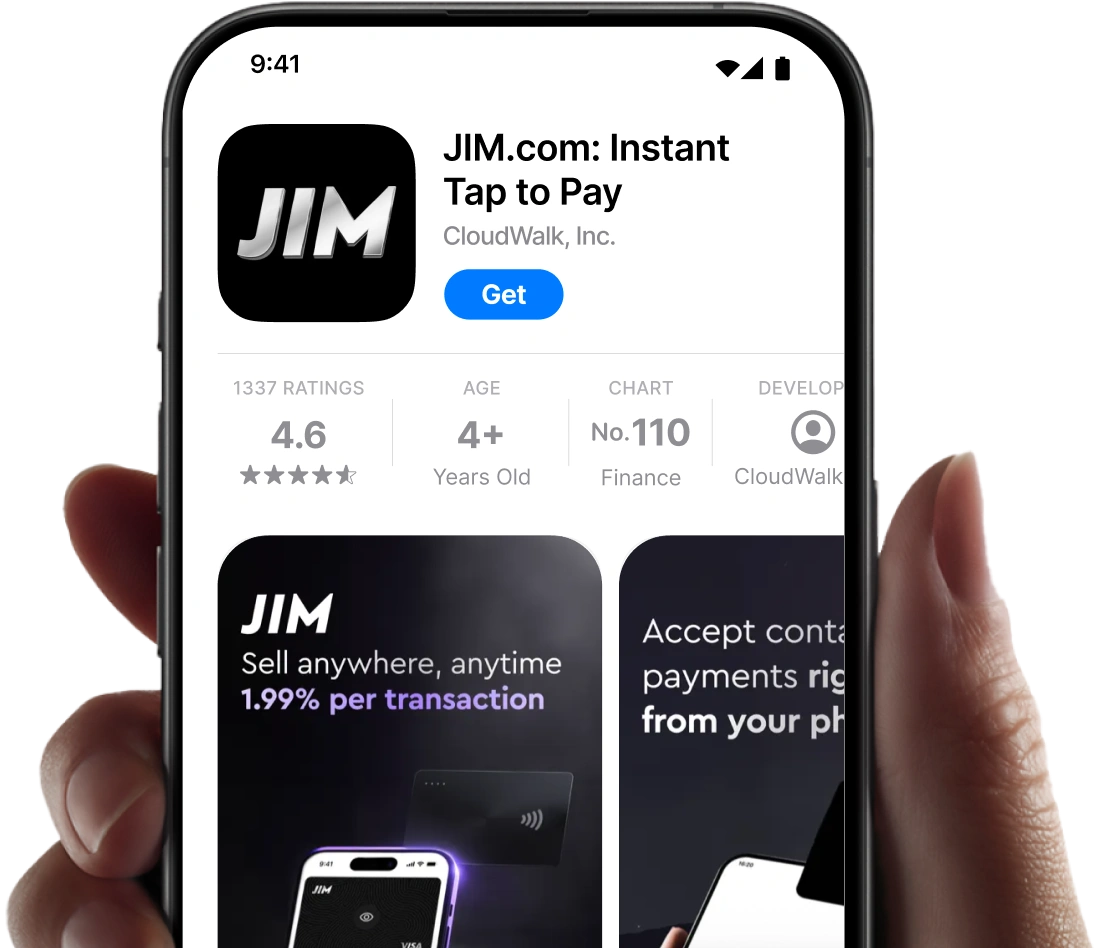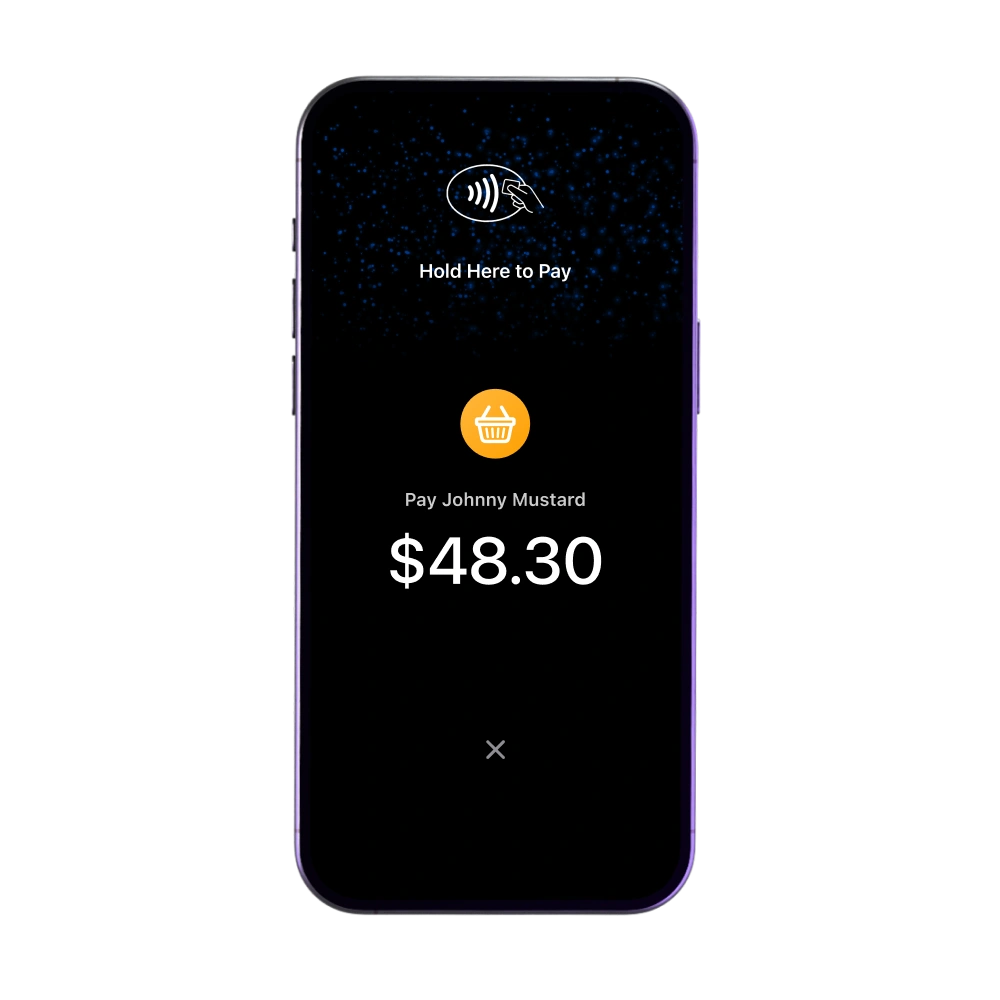Learn how digital wallet payments like Apple Pay and Google Pay work and how to start accepting them easily and securely.
As a business owner, you’re always balancing two goals: delighting customers and keeping operations running smoothly. Payments sit at the center of both. A slow checkout can undo the best product or service, while a fast one builds confidence and loyalty.
That’s where digital wallet payments come in. With Apple Pay, Google Pay, Samsung Pay, Alipay, and Amazon Pay, businesses can now accept contactless payments at the point of sale with just a tap or a scan. These options reduce friction, speed up lines, and create trust at checkout.
In this article, we’ll explore why digital wallets matter for modern merchants and how JIM makes it easy to start accepting them—right from your smartphone, with no setup costs.
How digital wallets work
Digital wallets connect directly with a business’s Point of Sale (POS) system to process payments quickly and securely. From the customer’s side, the process is simple: they open their wallet app—such as Apple Pay or Google Pay—select their preferred card, and complete the purchase with a tap or by scanning a QR code.
On the merchant side, the POS terminal (or online checkout system) receives the encrypted payment details instantly. The payment is then verified through the card network or bank and transferred to the merchant’s bank account, usually within one to two business days, depending on the payment provider.
Unlike traditional debit card or credit card transactions (e.g., Mastercard, Visa)—where customers must physically insert or swipe their card—digital wallet payments complete the process securely in the background with just a tap or scan. Because the customer’s actual card number is never shared, both the buyer and the merchant benefit from an added layer of security.
With contactless payments, the payment solution also automatically records each transaction, reducing manual work and making it easier for merchants to track sales.
Popular Types of Digital Wallets
Digital wallets may all serve the same purpose—making payments faster and more convenient—but each has its own strengths, features, and markets where it dominates. Some are tied closely to specific devices, like Apple Pay and Samsung Pay, while others such as Alipay and WeChat Pay have become part of everyday life in entire regions. Understanding the differences helps merchants know which wallets their customers are most likely to use and which ones to prioritize when setting up acceptance.
Apple Pay
Apple’s wallet is built into iPhones, iPads, Apple Watches, and Macs. It uses NFC technology for contactless payments and supports biometric authentication with Face ID or Touch ID.
Google Pay
Available on Android devices and the web, Google Pay allows in-store tap-to-pay, online checkouts, and peer-to-peer transfers. It’s widely accepted across global merchants.
Samsung Pay
Samsung’s wallet supports both NFC and Magnetic Secure Transmission (MST), making it compatible with older card readers as well as modern contactless terminals.
Alipay
One of the most popular wallets in China, Alipay combines payments with a wide range of lifestyle services. It’s also expanding globally, especially in travel and retail.
Amazon Pay
Amazon Pay lets customers use the payment methods already linked to their Amazon accounts, making online checkouts quicker and reducing the need to enter card details.
PayPal
A pioneer in digital payments, PayPal now doubles as a wallet for online and in-app purchases. It’s especially popular for e-commerce and cross-border transactions.
WeChat Pay
Another major player in China, WeChat Pay is integrated into the WeChat app. It allows users to pay for goods, transfer money, and even pay bills directly inside the app.
The growing popularity of digital wallets
In global payments, digital wallets have moved from niche to mainstream. In 2024, they already accounted for 31% of in-store transactions worldwide, and 53% of all online purchases, making them one of the leading payment options.
This growth is more than just numbers—it reflects a shift in consumer behavior. People are increasingly choosing speed and convenience over traditional card swipes or cash. J.D. Power’s 2024 study found that satisfaction with digital wallets rose from 660 to 664 points on a 1,000-point scale. The reason for this improvement is simple — digital wallets provide the speed, simplicity, and convenience that customers increasingly expect in 2025.
For merchants, these figures make the case clear. If more than half of online sales are being processed through digital wallets, businesses that don’t adapt risk losing relevance. And because satisfaction levels are directly linked to repeat purchases, adopting digital wallet payments is as much about keeping current customers happy as it is about attracting new ones.
What you need to accept digital wallet payments the conventional way
Accepting digital wallet payments in the traditional way usually requires several components working together. First, your business needs a payment processor that supports methods like Apple Pay, Google Pay, and other digital wallet payments. This processor acts as the middle layer, handling encryption and sending payment information through the credit card networks and banks. Alongside this, you need a Point of Sale (POS) terminal that supports near-field communication (NFC) for contactless payments, or a system that can generate QR codes for customers to scan.
Once these are in place, the process flows automatically. The customer taps their mobile device or scans a code, the encrypted details travel through your processor, the bank authorizes the transaction, and the money is routed to your merchant account. Depending on your provider, settlement may take one or more business days, and costs can vary depending on the amount, card type, or payment channel.
The core technologies behind digital wallet payments
Here are the core technologies that make digital wallet payments possible, starting with the most common one.
Near-Field Communication (NFC)
NFC is the most widely used technology for digital wallet payments. It enables two devices—like a smartphone and a payment terminal—to communicate securely when they’re only a few centimeters apart. Instead of swiping or inserting a physical card, the customer simply brings their device close to the terminal. The payment information is encrypted and sent wirelessly, which makes the process both fast and safe. For merchants, NFC means that a single POS terminal can accept a wide variety of digital wallets without needing extra hardware.
Magnetic Secure Transmission (MST)
Some digital wallets also support MST, a technology designed to work with older card readers that were built for magnetic stripes. The smartphone creates a magnetic signal that mimics the stripe of a debit or credit card.
From the terminal’s point of view, it looks just like a normal swipe, but in reality, the data is encrypted and transmitted digitally. Although MST is less common today than NFC, it has helped digital wallets gain traction in places where payment terminals haven’t yet been upgraded to support contactless payments.
QR codes
QR codes offer another path for digital wallet transactions. Instead of tapping a device through NFC or MST, the customer opens their wallet, scans a displayed code, and authorizes the payment. The code carries transaction details such as the merchant’s ID and purchase amount, and once scanned, the customer’s device transmits the approval back to the payment system. QR payments are especially popular in regions where NFC terminals are less common, and they provide an easy entry point for small businesses that don’t want to invest in additional hardware.
Once the customer’s payment details are transmitted through one of these methods, the merchant’s POS terminal sends the information to the payment processor. The processor then communicates with the issuing bank (the customer’s bank) and the acquiring bank (the merchant’s bank) to verify and settle the purchase. All of this happens in just a few seconds, which is why contactless digital wallet payments feel almost effortless at checkout.
The no-hardware way to accept digital wallets with JIM
For many merchants, adopting digital wallet payments the traditional way feels expensive and complicated. Buying POS terminals, setting up processors, and dealing with hidden fees often turns the process into something time-consuming and technical.
JIM makes it simple. With just a smartphone app, you can start accepting digital wallet payments—no extra hardware, no installation costs. Every payment is handled through an easy in-app transaction:
- Step 1: Download the JIM app on your iPhone.

- Step 2: When you’re ready to accept a payment, open the app, tap Sell, and have your customer hold their card, phone, or watch to your device.

- Step 3: Get your money instantly—available within seconds—and spend it anywhere using your JIM Visa Prepaid Card.
Unlike traditional processors that route funds through your bank with delays, JIM makes money available immediately. Each transaction is processed on the spot, with a flat 1.99% fee that stays the same regardless of payment size. For business owners, that predictability and ease reduce stress and make day-to-day operations far more straightforward.
Best of all, JIM manages the payment processing for you—so there’s no need to juggle complicated systems or third-party integrations.
Weighing the benefits and risks of digital wallets
Digital wallets are transforming how people pay—but like any technology, they come with both benefits and drawbacks.
For merchants, they promise faster and smoother payments, but there are also questions around costs, integration, and security. Many business owners hesitate because of perceived risks, while customers often worry about safety when storing payment cards on their devices. Below are pros and cons so you can weigh them for yourself.
Benefits of digital wallets
- Faster checkout process: Transactions are processed in just a few seconds, which keeps lines shorter and customers happier. This is efficient for busy retailers, cafés, or service providers where every minute counts.
- More convenient for customers: Digital wallet providers like Apple Pay and Google Pay allow shoppers to pay with just a tap of their phone or watch. No fumbling for the right card, no counting cash—just one quick action. The easier you make payment, the more likely customers are to return.
- Enhanced security features: Most mobile wallets use tokenization and encryption to protect card details. Combined with biometrics such as fingerprints or facial recognition, this adds an extra layer of security compared to traditional card swipes.
- Less cash handling: Fewer cash transactions mean less time spent counting money, fewer trips to the bank, and lower risks of theft. This also simplifies bookkeeping since more of your sales flow through digital records. The ability to skip physical cards makes checkout smoother and also reduces the risk of lost or stolen cards.
Risks of digital wallets
- System or network dependency: If your POS terminal, smartphone, or internet connection goes down, digital wallet payments can’t be processed. That means having a backup payment method is still essential.
- Customer adoption isn’t universal: While usage is growing fast, not every customer has switched to digital wallets. Some still prefer cash or traditional cards, which means merchants can’t rely on wallets alone.
- Potential security concerns: Although wallets are designed to be secure, no system is perfect. Lost or stolen devices, phishing attempts, or weak passwords can still put users at risk. Merchants need to reassure customers and use trusted providers to minimize this. Card and digital wallet payments are perceived by merchants as having the highest fraud rates among acceptance methods, even though they’re among the most widely used.
Start accepting digital wallet payments with JIM
JIM takes the hassle out of digital wallet payments. Instead of buying hardware or waiting days for settlement, you can accept payments right from your iPhone The process is simple: open the app, take the payment, and the money is available within seconds on your JIM Visa Prepaid Card.
With a flat 1.99% fee and no extra setup, JIM makes digital wallet payments easy to manage and easier to trust.















